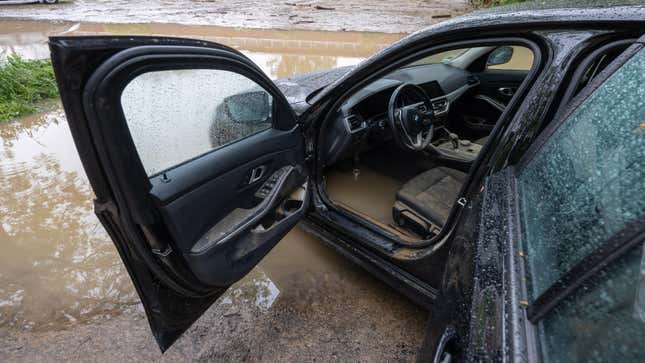If you’ve ever come across a screaming deal on a car you always wanted only to find out that it’s flood damaged, you’ve likely done the mental gymnastics to determine if buying a flood-damaged car really is that bad. Well, as it turns out, it is really that bad. Floods are the most common weather-related natural disaster in every state in the U.S., and thousands of cars are damaged or destroyed by floods every year. Flood damage disclosure regulations vary state-by-state, but some flood-damaged vehicles find their way back onto the market without any indications of their murky past. Here’s what to expect if you buy a flood-damaged vehicle.
The challenges that face flood-damaged cars are widespread and often invisible without disassembling the entire vehicle. As a reminder, water and electronics don’t mix well, and what are modern cars riddled with? That’s right, electronics. Water also doesn’t play nice with lubricants or mechanical systems. When a car is submerged, water finds its way into every nook and cranny of a vehicle, both visible and not immediately visible.
Airbag modules can be compromised, electrical connectors will be flooded, and the effects of this submersion are rarely immediately apparent. Corrosion takes time to set-in and start truly ruining electronics. Sometimes it takes months, sometimes years. Flood-damaged cars are likely to continuously encounter issues with corrosion, and not just on the body but also in vital electrical components that are needed for a vehicle to operate properly. These issues are liable to persist for the remainder of the vehicle’s lifetime. Consumer Reports says,
CR’s chief mechanic, John Ibbotson, says to avoid vehicles with signs of deep-water exposure “even if a vehicle looks acceptable and may be working when you inspect it.” That’s because the long-term effects of water damage can haunt buyers for the life of the car.”

Carfax says nearly 400,000 flood-damaged cars were back on the road in 2022. If you’re trolling the used car market to find a good deal, make sure that you thoroughly inspect a vehicle for signs of flood damage before signing on the dotted line. Due to loopholes and inconsistencies in legislation, flood damaged vehicles rarely have their watery history reported on the vehicle’s title, so it’s not uncommon to encounter flood-damaged vehicles being resold across the country. In fact, flood-damaged vehicles are often shipped to different regions where signs of flood damage are less well-known.
When checking to see if a vehicle has flood damage, check carpets for mud or musty smells, and inspect seat mounts for signs of removal. Look in difficult-to-clean places like between panels, under the hood, and in the trunk for mud or debris, and look at the rubber drain plugs on the underside of the doors for signs of removal. Finally, check the engine oil for a milkshake appearance (indicative of water mixed with oil), and check the air filter to see if there are signs of water damage.
Carfax also offers free flood damage checks with vehicle its history reports, and the National Motor Vehicle Title Information System is a great resource meant to protect buyers from title washing, when cars are totaled or stolen and get clean new titles due to legal loopholes. If you’re considering buying a flood damaged car, proceed with extreme caution, and know the risks of what you’re getting into. If you’re buying on the used market, look for the signs of flood damage so you don’t end up underwater.

